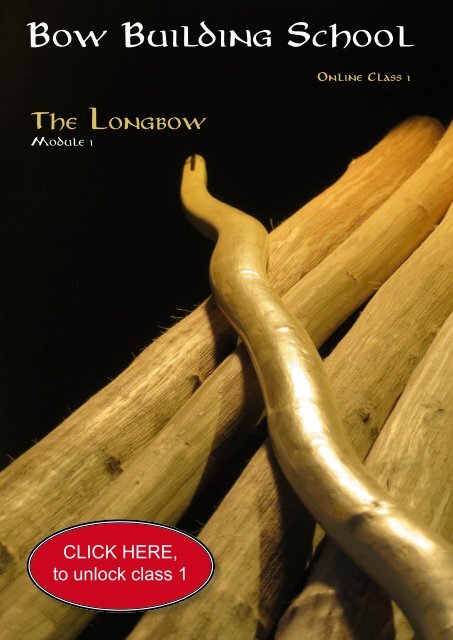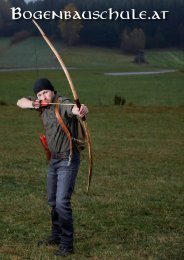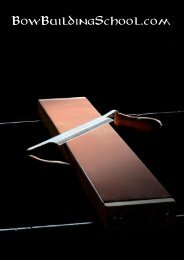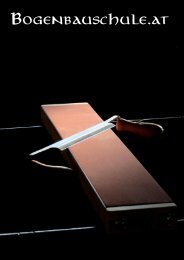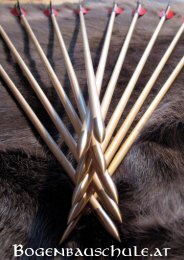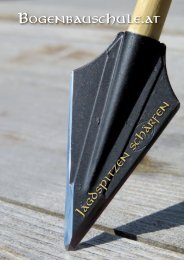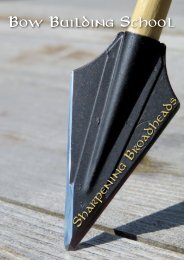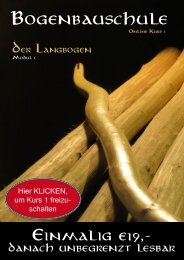You also want an ePaper? Increase the reach of your titles
YUMPU automatically turns print PDFs into web optimized ePapers that Google loves.
Bow Building School<br />
Online Class 1<br />
<strong>The</strong> <strong>Longbow</strong><br />
<strong>Module</strong> 1<br />
CLICK HERE,<br />
to unlock class 1
In a hundred years this will be a magnificent yew grove.<br />
Imprint<br />
Publisher and owner:<br />
Matthias Wiltschko, A-3920 Gross Gundholz 25<br />
www.traditionellerbogenbau.at<br />
Publisher and media owner takes no liability.<br />
All rights, copying, distribution and translation rights are with the owner<br />
and publisher.<br />
Photos, graphics and videos: Matthias Wiltschko<br />
Layout: Matthias Wiltschko<br />
No liability for injuries and damage to property of the customer / reader<br />
and third parties is taken over by the information provided and by<br />
the objects produced therefrom (eg bows, arrows, ...). Each customer<br />
/ reader is responsible for his / her own safety and safety in dealing<br />
with his / her own manufactured bows and arrows. It is at the measure<br />
of the customer / reader to judge the wood used by him / her on<br />
its resistance to breakage. Published dimensions of bows refer only<br />
to the bows produced by the publisher. Applying these dimensions to<br />
customer / reader‘s own bows can result in breakage of the bow since<br />
the same wood properties are not given.
<strong>The</strong> <strong>Longbow</strong> <strong>Module</strong> 1<br />
Acknowledgments<br />
I want to thank Paul Comstock. During the English translation he helped<br />
me to make this Online Class easier to understand for novices. He<br />
drew my attention to add important topics and to define fundamental<br />
terms even more precisely.<br />
I thank my parents very much. <strong>The</strong>ir support enabled me to realize this<br />
Online Course. Above all, I thank my father. He taught me to distinguish<br />
our native trees, shrubs and their wood. Since my beginnings as a<br />
bowyer he provides me with the best local bow wood.<br />
I thank my mother for proofreading and for the help to make this course<br />
comprehensible also for beginners.<br />
Ever since I started my bow making, my girlfriend Gerda accompanies<br />
me with constructive suggestions and supports me in my projects. She<br />
plays a key role in the visual design of this course and my websites.<br />
Many thanks to my uncle Erwin. He showed me, in my beginnings as<br />
a bowyer, based on his own bows the various bow designs and bow<br />
woods. Even as a child I shot with one of his bows from the branch<br />
of an apple tree. Again and again he surprises me with special bow<br />
wood.<br />
Many thanks to my uncles Pepp, Walter and Ernst. A lot of my bows<br />
grew in their forests.<br />
Thanks to Ao.Univ.Prof. Dr. phil. Birgit Kartusch, my botany professor<br />
at the University of Natural Resources and Applied Life Sciences in<br />
Vienna. She taught me to look for the performance of my bows inside<br />
the wood, supported me with valuable literature, and made the photos<br />
of the microscopic wood samples for me.<br />
To Dipl.-Ing. Dr.nat.techn. Michael Grabner of the University of Natural<br />
Resources and Applied Life Sciences I owe my knowledge of wood<br />
biology and wood quality. With his support, the X-ray images, density<br />
measurements and strength measurements of my bow woods were<br />
created.
When I started making bows in 2007, I only had the Traditional Bowyer‘s<br />
Bible Volume 1 as literature, insatiable curiosity and thirst for knowledge.<br />
I had no idea what this Osage Orange is, let alone how to pronounce it correctly.<br />
At that time yew was still a deciduous tree and when I stood before<br />
a supposed specimen of this genus, it was a Moravian rowan.<br />
<strong>The</strong> small, two-meter-high yew, which my father had planted 15 years earlier,<br />
grew in its shadow and was not noticed by my untutored eye. I knew<br />
some of our native trees and shrubs, but I had not seen this unimposing<br />
plant before.<br />
After the first pages of the TBB (Traditional Bowyers Bible) I was immediately<br />
under the spell of traditional bow making. I was amazed by the accumulated<br />
knowledge of bow wood and the depth of this topic.
<strong>The</strong> <strong>Longbow</strong> <strong>Module</strong> 1<br />
Overwhelming were the possibilities of bow designs. Should it be a longbow?<br />
No, I do not have yew wood. It will not be an Osage bow either, this<br />
wood does not grow in my area. Do I need a rawhide or sinew backing to<br />
keep my bow from breaking? ...<br />
Which bow design should I build first?<br />
Initially I was fascinated by archery and sought a balance to my former<br />
mobile computing studies, which took place days and nights in front of the<br />
computer monitor.<br />
For me it was immediately clear that I would shoot only with a self-built<br />
bow. <strong>The</strong> greatest fascination was and still is to make a bow with the simplest<br />
means and the least amount of money.<br />
Terminal shoot of a yew. After the bowyer‘s-fever had seized me, my<br />
father and I planted more yew trees on our property. Partial shade and<br />
lean soil are very suitable for these trees. Where other trees struggle,<br />
yew feels comfortable. But do not forget that all plant parts of yew are<br />
poisonous!
I did not expect the variety of possible bow designs and the knowledge that<br />
is needed to build a bow.<br />
On the one hand my curiosity was even more incited, and I was glad to<br />
have found a topic that would fascinate me for many years to come.<br />
On the other hand, I was not only slowed down by the sheer mass of information,<br />
the undefined stress limits of the wood that must not be exceeded<br />
and the freely selectable variables such as bow wood, limb width, bow<br />
length, ... In my intention to build a simple bow, I was stopped.<br />
<strong>The</strong> TBB offered a lot of valuable knowledge and gave me all the possibilities<br />
and the liberty to build an infinite number of different bows.<br />
But actually I would have searched for one particular sentence in the<br />
book:<br />
„Your first bow will be a longbow!“<br />
Yew bark with the typical small shoots that drive out of the entire trunk.<br />
Not only bark, wood and needles, but also the pollen of male yew is<br />
poisonous.
<strong>The</strong> <strong>Longbow</strong> <strong>Module</strong> 1<br />
Elaborately crafted longbow made of Osage Orange (origin Nebraska)<br />
with deer rawhide backing, leather handle built on the back of the bow,<br />
flax windings and buffalo horn overlays for the string nocks.
Your Bow<br />
It does not always have to be Yew. Our well-available bow woods such<br />
as Hazel, Maple, Ash, Elm and many more allow us to make outstanding<br />
longbows. <strong>Longbow</strong>s from white woods are in no way inferior in their performance<br />
to the highly acclaimed yew bows and can even surpass them.<br />
It is always important to adapt the bow design to the wood used. I will show<br />
you how to assess the wood density, wood strength and restoring force of<br />
bow woods and how to find out the right dimensions for your longbows.<br />
Since very fine dust is released when debarking Yew staves, a high<br />
quality dust mask should always be worn.<br />
But you can make it much easier and less harmfull by using our wellavailable<br />
bow woods such as hazel, ash, maple, ....
<strong>The</strong> <strong>Longbow</strong> <strong>Module</strong> 1<br />
Hazel longbow built with the least expenditure of money and material.<br />
In terms of performance, this bow is identical to the very costly Osage<br />
longbow shown above.
10
<strong>The</strong> <strong>Longbow</strong> <strong>Module</strong> 1<br />
A selfbow can be a powerful weapon. While testing my first Ash bow,<br />
one of the arrows was abruptly stopped. <strong>The</strong> high voltage power line<br />
was split by a simple field point and the tip got stuck between the wires.<br />
After a few cold days the arrow popped out again.<br />
11
This is how it continues in <strong>Module</strong> 1<br />
Avoid inefficient tiller shapes<br />
Long bows vs. short bows<br />
CLICK HERE,<br />
to unlock class 1<br />
12
<strong>The</strong> <strong>Longbow</strong> <strong>Module</strong> 1<br />
Minimizing Set und Stringfollow<br />
<strong>Longbow</strong>s vs. Flatbows<br />
13
<strong>Module</strong> 2<br />
Trees and bow wood - Basics<br />
Wood structure,<br />
quality determination,<br />
wood moisture, wood<br />
strength, modulus of elasticity,<br />
X-ray pictures with exact density<br />
profiles, mechanical properties of<br />
wood, elasticity, flexibility, restoring<br />
force, ... and much<br />
more.<br />
14
<strong>The</strong> <strong>Longbow</strong> <strong>Module</strong> 1<br />
CLICK HERE,<br />
to unlock class 1<br />
15
<strong>Module</strong> 3<br />
Saplingbows - Bows made from<br />
small diameter trees<br />
Buildalong for a <strong>Longbow</strong><br />
incl. Tillering and Video<br />
Wood harvesting,<br />
drying, defect handling,<br />
storage, curvature correction,<br />
correct use of tools, increasing efficiency,<br />
how to avoid set, stringfollow<br />
and chrysalis,<br />
bow finishing<br />
CLICK HERE,<br />
to unlock class 1<br />
16
17<br />
<strong>The</strong> <strong>Longbow</strong> <strong>Module</strong> 1
<strong>Module</strong> 4<br />
<strong>The</strong> Ash Snake<br />
Making of a Character bow<br />
18
<strong>The</strong> <strong>Longbow</strong> <strong>Module</strong> 1<br />
Proper handling<br />
of torsions, grain<br />
alignment, deadwood,<br />
bark defects, character<br />
bow tillering, tip reinforcements,<br />
...<br />
CLICK HERE,<br />
to unlock class 1<br />
19
<strong>Module</strong> 5<br />
Draw Knife - Bowyer‘s hatchet<br />
Handling and<br />
hand posture, cut<br />
types, prevention of fiber<br />
tearing, methods for fast<br />
wood reduction, blade<br />
steel, blade shapes,<br />
...<br />
20
<strong>The</strong> <strong>Longbow</strong> <strong>Module</strong> 1<br />
CLICK HERE,<br />
to unlock class 1<br />
21


